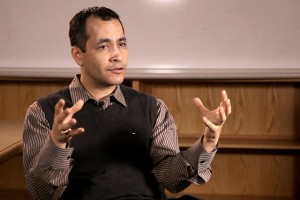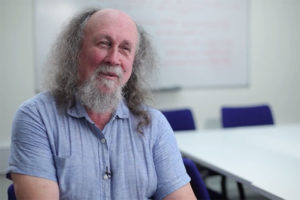Free Energy Principle
Neuroscientist Karl Friston on the Markov blanket, Bayesian model evidence, and different global brain theorie...
There is a book that was published in 1913 by a man named Stéphane Leduc. He published in in the French language and, therefore, the book has a French title La biologie synthétique. What he meant was constructing artificial life. Back in 1913 there was the chemistry tradition where people were isolating natural products from living systems determining their molecular structures and then synthesizing the molecules. There was some degree of vision whereby Leduc understood that in the future people would try to synthesize life.
One of the questions whenever you do synthesis is how much do you change what you already have. Every time you have a baby you synthesize life but it is a natural synthesis. The baby is different from the parents but not very different. One of the big questions in synthesis is to try to extend away from natural, animal husbandry. Synthetic biology has been going on for billions of years where you have the chemist intervene within the living system and try to make the life not entirely natural but try to do something unnatural, make a new compound or a new species of molecule. That still performs like life performs – but with a different molecular structure. Where we got into this field was trying to say ‘Wait a minute, DNA has four nucleotides – G, A, C and T – the genetic information is determined by their order. But if you draw the molecular structures of nucleic acids on a sheet, you all of a sudden realize that there is more than just four that you could have’. You could have six, eight, ten or even twelve nucleotides that fit Watson-Crick geometry and should be able to form from twelve nucleotides sex base pairs and be replicated just like natural DNA as with four nucleotides and two base pairs.
A third group of people that came in and basically called synthetic biology ‘bioengineering’. This goes back to the 1970s where recombinant DNA technologies, biotechnologies allow you to pick genes from here and pick genes from there, bring them together into one organism so you can design a new pathway to make a chemical, a natural product of some kind by combining enzymes from different sources that have different catalytic processes. Synthetic biology also came to mean the opposite of what I just described. For us synthetic biology means using unnatural building blocks to do natural things, like evolve and adapt. To the biotechnology synthetic biology means using natural things, natural pieces to do unnatural outcomes like making a new chemical synthesis.
The United States government, for example, has many millions of dollars in DARPA now going to the second meaning of synthetic biology. One of the promises has been that we would be able to standardize natural biological parts, like Legos, so that you could put them together without having to do too much work. They would be interchangeable parts. So that’s synthetic biology definition and its broadest example. Two examples have been now the creation of artificial genetic systems and the second is the rearrangement of natural genetic systems that create artificial products and metabolites.
Today if you drink vitamin C or your fruit drink, a lot of that vitamin C is manufactured by an enzymatic process. That is in a sense synthetic biology. Citric acid also many compounds are now made by natural fermentation in organisms that have been engineered using the second kind of synthetic biology. For new kinds of DNA this has now been widely used in human diagnostics, for example. If you have HIV or hepatitis B you will now go to the hospital and have the level of virus load measured using artificial genetic systems because they give you very clean, few false positives, very quantitative output. They are not interfered by any of the natural DNA you have. Also, if you are worried about Ebola, noroviruses or intro viruses – these are all RNA viruses – in synthetic biology unnatural nucleic acid is being used, so we can detect these viruses on an airplane, in an ambulance and apartment building at points of sample. We don’t have to send the sample away to a hospital or a clinic to determine what those are.
So now you can ask the question of how do we design artificial genetic systems. For this we go back to the structure of the Watson-Crick base pair. Watson and Crick recognized that DNA (eight pairs with T, G pairs with C – natural DNA), the DNA base pair comes from a geometry where big purine adenine pairs with a small perimeter implementing a big guanine pair with a small cytosine. But then you have hydrogen bond donors and acceptors on the bases. Two hydrogen bond donors on the guanine and one hydrogen bond acceptor pairs with two
hydrogen bond acceptors on the cytosine and one hydrogen bond donor on the cytosine. It’s this pairing of that allows the base pairing to be specific in addition to big pairing with small.
What we have done to create extra letters in the genetic alphabet it’s just change the patterns of hydrogen bond donors and acceptors. We still have a big base and a small base, big still pairs with small, but we have shuffled all the hydrogen bond donors and acceptors to allow the Watson-Crick pair to form with six, eight, ten or twelve letters in the genetic alphabet, not just four. Of course, that involves a lot of organic chemical synthesis which is a very big part of what we do in the laboratory. But we also have to develop the supporting molecular biology. Remember, it’s very easy to synthesize GACT DNA because you have enzymes that DNA polymerizes and that will copy GACT DNA polymerase to give CGTT as the copy. We have to develop polymerases that will not only copy G,A, C and T, but also two extra letters like S and B. Or two more actual letters loke P and Z. We have alphabets that have eight letters, and then we have DNA polymerases that copy them.
You might want to know how you can use these. These are parts of diagnostics tools, and they are very important for detecting nucleic acids in the environment. Very often, especially with infectious disease you want to know, whether a patient has Ebola, whether a mosquito is carrying yellow fever, Dengue fever or some other virus. The very easy, simple and clean ability of unnatural genetic systems to work in a world of natural DNA where there is no interference – they are unnatural and the natural DNA is different – allows you to detect infectious agents very easily in complex environments with very little background noise and very little mistakes. It’s pretty important when you’re trying to detect infectious diseases, like Dengue in a mosquito or Ebola in a patient, you do not want to make mistakes.
The future, of course, is even bigger than this. Right now almost all of synthetic biology takes place in test tubes. Putting unnatural systems into bacteria is only a start. For example, when you have extra letters in the DNA alphabet, you can start writing extra words in the genetic code. This means that a bacteria not only need not have four nucleotides – they can have six but it also is not any longer limited to 20 amino acids in the proteins. They can have 24 different amino acids. All of biotechnology can be based on your design, not what four billion years of biological evolution has provided, because – nothing personal, but your biochemistry is not perfect – you have 20 amino acids, but because you only have 20 amino acids, you must eat vitamins, for example. So much better it would be if you had 21 amino acid, where the vitamin was incorporated into the amino acid, and therefore protein had greater power.
We don’t believe that there’s going to be any Frankenstein in your future, obviously. These are still microorganisms, and, of course, the microorganisms are very unnatural, which means that they are not tasty, you don’t eat them, they don’t find you to be tasty either. They will not eat you, but they are very useful for manufacturing unusual compounds that can be used in manufacturing chemicals food, diagnostics and medicines.

Neuroscientist Karl Friston on the Markov blanket, Bayesian model evidence, and different global brain theorie...

Bioengineer Ali Khademhosseini on creating new biomaterials, microengineering, and mimicking embryonic develop...

Professor of Biosphere and Climate Impacts Iain Colin Prentice on global warming, the science of ecology, and ...